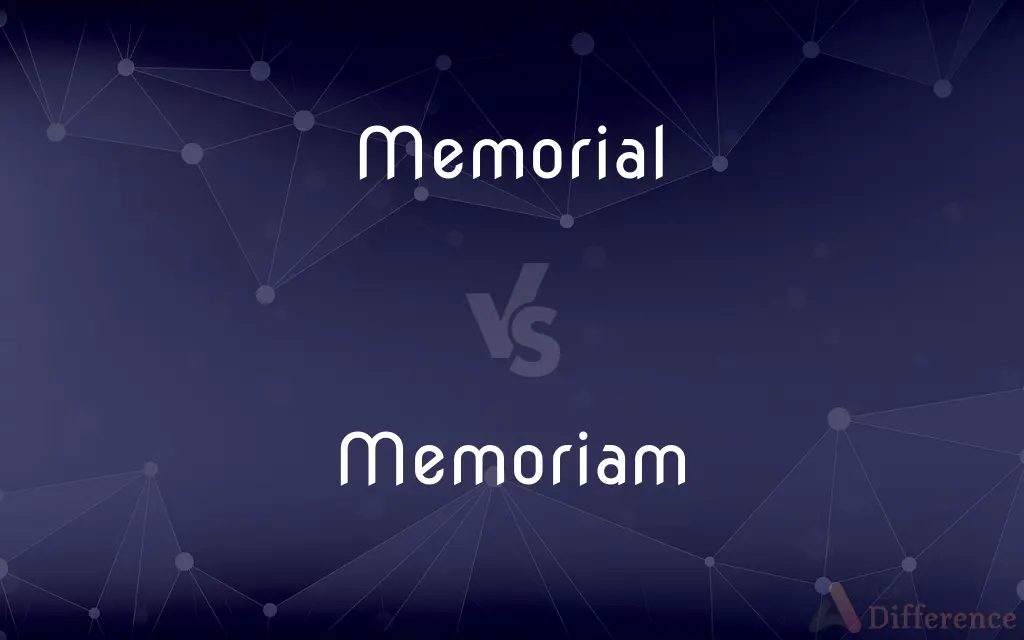Memorial vs. Memoriam — What's the Difference?
By Maham Liaqat & Fiza Rafique — Updated on February 26, 2024
Memorial is a physical or digital tribute to remember someone, often public; "In memoriam" is a phrase used in dedications to honor the deceased, typically in private contexts.

Difference Between Memorial and Memoriam
Table of Contents
ADVERTISEMENT
Key Differences
A memorial is a structure, object, or event created to commemorate a person or event, often accessible to the public and designed to evoke memory and reflection. It serves as a tangible representation of remembrance, ranging from monuments and plaques to memorial services and digital tributes. "In memoriam," on the other hand, is a Latin phrase meaning "in memory of," used primarily in dedications or titles of works, such as poems, obituaries, or acknowledgments, to honor someone who has died. This phrase signifies a more personal or literary form of tribute, focusing on the act of remembering and honoring the deceased through words and expressions of grief or admiration.
Memorials are usually created with a sense of permanence and can be found in public spaces, cemeteries, or online platforms, allowing for communal participation in the act of remembrance. They often become sites of gathering for anniversaries or commemorative events. Conversely, "in memoriam" tributes are typically shared among friends, family, or within specific communities, appearing in written forms such as books, articles, or on social media, serving as a private or intimate acknowledgment of loss and remembrance.
The creation of a memorial often involves formal planning, funding, and design, reflecting collective memory and public sentiment towards the person or event being commemorated. It symbolizes a shared history or tragedy, aiming to educate or inspire future generations. "In memoriam" tributes, while possibly public, tend to be more personal, capturing individual emotions and memories, and do not require the logistical planning that physical memorials do.
Choosing between establishing a memorial or creating an "in memoriam" tribute depends on the intended audience, the nature of the remembrance, and the desired impact. While memorials offer a physical space for reflection and communal memory, "in memoriam" expressions provide a personal touch, often encapsulating the emotional essence of the individual or event being remembered.
Both forms of remembrance play crucial roles in the process of mourning and memory, offering different avenues for expressing grief, respect, and homage. They contribute to the cultural and historical narrative of communities and individuals, ensuring that those who have passed are not forgotten.
ADVERTISEMENT
Comparison Chart
Nature
Physical or digital tribute
Phrase used in dedications
Purpose
Commemorate a person/event publicly
Honor someone deceased privately or in writings
Location
Public spaces, online
Books, obituaries, social media
Form
Monuments, services, websites
Dedications, poems, acknowledgments
Audience
General public, communities
Friends, family, specific communities
Planning Required
Yes, often involves formal planning and design
No, more personal and requires less logistical planning
Duration
Designed for permanence
Temporal, depending on the medium
Emotional Aspect
Reflects collective memory and public sentiment
Captures individual emotions and memories
Compare with Definitions
Memorial
A ceremony to remember and honor the deceased.
The memorial service drew hundreds of mourners.
Memoriam
A poem or literary piece dedicated to the deceased.
Tennyson's In Memoriam reflects his grief and mourning.
Memorial
A monument or service commemorating a person or event.
The Vietnam Veterans Memorial honors U.S. service members.
Memoriam
An obituary tribute honoring a deceased individual.
Her In Memoriam column celebrated her grandmother's legacy.
Memorial
Public artwork or installation for commemoration.
The community unveiled a memorial garden.
Memoriam
A statement or acknowledgment of remembrance.
The conference began with an In Memoriam for its founder.
Memorial
An object or structure established for remembrance.
The memorial plaque bears the names of the fallen.
Memoriam
Phrase used to dedicate works to someone's memory.
The book's preface is titled In Memoriam for the author's mentor.
Memorial
A digital platform or website dedicated to memory.
The online memorial features photos and stories.
Memoriam
Social media posts commemorating someone's life.
Friends shared In Memoriam posts to honor his memory.
Memorial
A memorial is an object which serves as a focus for the memory or the commemoration of something, usually an influential, deceased person or a historical, tragic event. Popular forms of memorials include landmark objects or works of art such as sculptures, statues or fountains and parks.
Memorial
A statue or structure established to remind people of a person or event
A memorial to General Robert E. Lee
Memorial
A statement of facts, especially as the basis of a petition
The Council sent a strongly worded memorial to the Chancellor of the Exchequer
Memorial
Something, such as a monument or holiday, intended to celebrate or honor the memory of a person or an event.
Memorial
Serving as a remembrance of a person or an event; commemorative.
Memorial
Of, relating to, or being in memory.
Memorial
(obsolete) Memory; recollection.
Memorial
Something, such as a monument, by which someone or something is remembered.
Memorial
A service of remembrance or commemoration.
Memorial
Serving as a remembrance of someone or something; commemorative.
A memorial building
Memorial
Contained in memory; as, a memorial possession.
Memorial
Memory; remembrance.
Precious is the memorial of the just.
Common Curiosities
Can "In Memoriam" be part of a memorial?
Yes, "In Memoriam" can be inscribed on memorials or used in memorial services as part of the dedication.
Are memorials only for individuals?
No, memorials can commemorate individuals, groups, or significant events, reflecting collective memory and history.
Do all memorials require physical space?
No, digital memorials are increasingly common, allowing for virtual spaces of remembrance accessible to wider audiences.
How long after someone's passing is it appropriate to create a memorial or "In Memoriam" tribute?
There's no specific timeline for creating a memorial or "In Memoriam" tribute; it can vary based on cultural practices, personal grief processes, and the planning required for the tribute.
What's the difference between a memorial and "In Memoriam"?
A memorial is a tribute, often physical, to remember someone publicly, while "In Memoriam" is a phrase for dedications in memory of the deceased, typically in private or written contexts.
How do people choose between creating a memorial or an "In Memoriam" tribute?
The choice depends on the nature of the remembrance, the intended audience, and the desired permanence or personal touch of the tribute.
Can "In Memoriam" tributes be made for events?
While less common, "In Memoriam" can be used to honor significant events, especially in literary or artistic expressions.
What makes "In Memoriam" tributes unique?
"In Memoriam" tributes are unique for their personal and emotional depth, often reflecting the individual relationship with the deceased or the personal impact of their loss.
Is a memorial service the same as an "In Memoriam" tribute?
A memorial service is a ceremony to honor the deceased, which can include "In Memoriam" tributes, but they are not synonymous; "In Memoriam" specifically refers to dedications or titles in written works.
Are there any restrictions on what can be included in a memorial or "In Memoriam" tribute?
Restrictions can depend on the context and platform (e.g., public space regulations for memorials or publication guidelines for "In Memoriam" writings). Generally, tributes should respect the deceased's memory and be considerate of the audience's feelings.
Can memorials and "In Memoriam" tributes help with the grieving process?
Yes, both memorials and "In Memoriam" tributes can provide a sense of closure, serve as a focal point for grief, and offer a way to publicly or privately acknowledge and remember the deceased, aiding in the grieving process.
Who typically initiates the creation of a memorial or "In Memoriam" tribute?
Family members, friends, community leaders, or organizations associated with the deceased might initiate a memorial. "In Memoriam" tributes are often created by close associates, family, or individuals moved by the loss.
Can memorials and "In Memoriam" tributes evolve over time?
Memorials, especially digital ones, can evolve with contributions from the community. "In Memoriam" tributes in digital formats or ongoing publications can also be updated or added to, reflecting lasting memories and ongoing remembrance.
Share Your Discovery

Previous Comparison
Layoff vs. Redundancy
Next Comparison
Ethane vs. EthyleneAuthor Spotlight
Written by
Maham LiaqatCo-written by
Fiza RafiqueFiza Rafique is a skilled content writer at AskDifference.com, where she meticulously refines and enhances written pieces. Drawing from her vast editorial expertise, Fiza ensures clarity, accuracy, and precision in every article. Passionate about language, she continually seeks to elevate the quality of content for readers worldwide.
















































